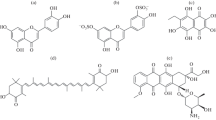Abstract
In order to investigate a possible relationship between the intensity of lipid peroxidation (LP) in tumor cells and their proliferative activity various methods to quantify LP are desirable. In this study the decrease in the contents of fatty acids and glutathione was measured by established methods inEhrlich ascites tumor (EAT) cellsin vitro, in which LP was stimulated by the addition of ferrous iron, either as free ion or as histidinate chelate.
When EAT cells were incubated for 30 min at 37 °C in the presence of 5 mM FeSO4 the following changes were observed in comparison to appropriate control cells: The content of reduced glutathione (GSH) and total glutathione (GSH+2 GSSG) decreased significantly by 24 and 30% respectively. The decrease of 4 unsaturated (C 18:1; C 18:2; C 20:4; C 22:6) and 2 saturated fatty acids (C 16:0; C 18:0) by about 15% on the average was statistically significant only for C 16:0 and C 20:4).
More pronounced effects were observed with 5 mM Fe(II)-histidinate. GSH and GSH+2 GSSG decreased by 54% and 40%, resp. The decrease of fatty acids by about 40% on the average was significant for all of the 6 fatty acids tested. These results are in agreement with previous studies on LP in EAT cells showing Fe(II)-histidinate to be a more powerful promoter of LP compared with free ferrous ion. The observation, that the content not only of GSH but also of total glutathione was decreased in iron-treated tumor cells is in contradiction to the hypothesis that GSH may act as a mere redox mediator of LP under the conditions used and points to a consumption of GSH by several possible pathways. The finding of decreased levels of unsaturated as well as saturated fatty acids in the presence of Fe(II)-histidinate underlines the extraordinary potency of iron as an initiator and catalyst of LP.
Zusammenfassung
Um eine mögliche Beziehung zwischen der Intensität der Lipid-Peroxidation (LP) in Tumorzellen und deren Proliferationsaktivität zu untersuchen, sind mehrere Methoden zur Quantifizierung der LP wünschenswert. In dieser Arbeit wurde die Abnahme von Glutathion und von Fettsäuren mittels etablierter Verfahren inEhrlich-Ascites-Tumor-(EAT)-Zellenin vitro gemessen, in denen die LP durch Zugabe von zweiwertigem Eisen, entweder als freies Ion oder als Histidin-Komplex, stimuliert worden war.
Nach Inkubation von EAT-Zellen 30 min bei 37°C in Gegenwart von 5 mM FeSO4 wurden gegenüber geeigneten Kontrollzellen folgende Änderungen festgestellt: Die Konzentration an reduziertem Glutathion (GSH) und Gesamtglutathion (GSH+2 GSSG) nahm signifikant um 24 bzw. 30% ab. Die Abnahme von 4 ungesättigten (C 18:1; C 18:2; C 20:4; C 22:6) und 2 gesättigten (C 16:0; C 18:0) Fettsäuren um durchschnittlich ca. 15% war nur im Falle von C 16:0 und C 20:4 statistisch signifikant.
Ausgeprägtere Effekte wurden mit 5 mM Fe(II)-histidinat beobachtet. GSH und GSH+2 GSSG nahmen um 54 bzw. 40% ab. Die Abnahme der Fettsäuren um durchschnittlich ca. 40% war in allen Fällen signifikant. Diese Ergebnisse stimmen mit vorhergehenden Untersuchungen über die LP in EAT-Zellen überein, wonach Fe(II)-histidinat ein wirksamerer Promotor der LP ist als freie Fe2+-Ionen. Die Beobachtung, daß nicht nur GSH, sondern auch das gesamte Glutathion in den eisen-enthaltenden Tumorzellen abnahm, steht in Widerspruch zur Hypothese, daß GSH unter den gegebenen Bedingungen nur als Redoxvermittler der LP wirkt und deutet auf einen Verbrauch von GSH hin, wofür mehrere Wege möglich sind. Die Feststellung eines erniedrigten Spiegels sowohl der ungesättigten als auch der gesättigten Fettsäuren unterstreicht die außerordentliche Potenz des Eisens als Initiator und Katalysator der LP.
Similar content being viewed by others
References
Winkler P, Schaur RJ, Schauenstein E (1984) Biochim Biophys Acta 796: 226–231
Kosower NS, Kosower EM (1980) The glutathione-glutathione disulfide system. In:Pryor WA (ed) Free radicals in biology, vol 2. Academic Press, New York, pp 55–84
Kosower NS, Kosower EM (1978) Int Rev Cytol 54: 109–160
Sies H, Akerboom TPM, Cadenas E (1982) Biochem Soc Transactions 10: 79–80
Meister A, Anderson ME (1983) Ann Rev Biochem 52: 711–760
Schindler R (1971) Über die Wirkung von 4-Hydroxy-pentenal auf den SH-Gehalt verschiedener Tumoren und Normalgewebe. Dissertation, University of Graz, p 30
Chow CK, Tappel AL (1972) Lipids 7: 518–524
Wood R (1973) In:Wood R (ed) Tumor lipids: biochemistry and metabolism. Am Oil Chem Soc Press-Champaign, Illinois, 139–182
Ellman GL (1958) Arch Biochem Biophys 74: 443–450
Bernt E, Bergmeyer HU (1974) Glutathione. In:Bergmeyer HU (Hrsg) Methoden der enzymatischen Analyse, vol 2. Verlag Chemie, Weinheim, pp 1688–1692
Folch J, Lees M, Sloane Stanley GH (1957) J Biol Chem 226: 497–509
Morrison WR, Smith LM (1964) J Lipid Res 5: 600–608
Winkler P, Lindner W, Esterbauer H, Schauenstein E, Schaur RJ, Khoschsorur GA (1984) Biochim Biophys Acta 796: 232–237
Akerboom TPM, Sies H (1981) Methods Enzymol 77: 373–382
Rossi MA, Cecchini G (1983) Cell Biochem Funct 1: 49–54
Esterbauer H, Zollner H, Scholz N (1975) Z Naturforsch 30c: 466–473
Demopoulos HP (1973) Fedn Proc 32: 1903–1908
Tillian HM, unpublished results
Author information
Authors and Affiliations
Additional information
This work was supported by the Association for International Cancer Research, St. Andrews, U.K.
Rights and permissions
About this article
Cite this article
Schaur, R.J., Winkler, P., Hayn, M. et al. Decrease of glutathione and fatty acids during iron-induced lipid peroxidation inEhrlich ascites tumor cells. Monatsh Chem 118, 823–830 (1987). https://doi.org/10.1007/BF00809232
Received:
Accepted:
Issue Date:
DOI: https://doi.org/10.1007/BF00809232




